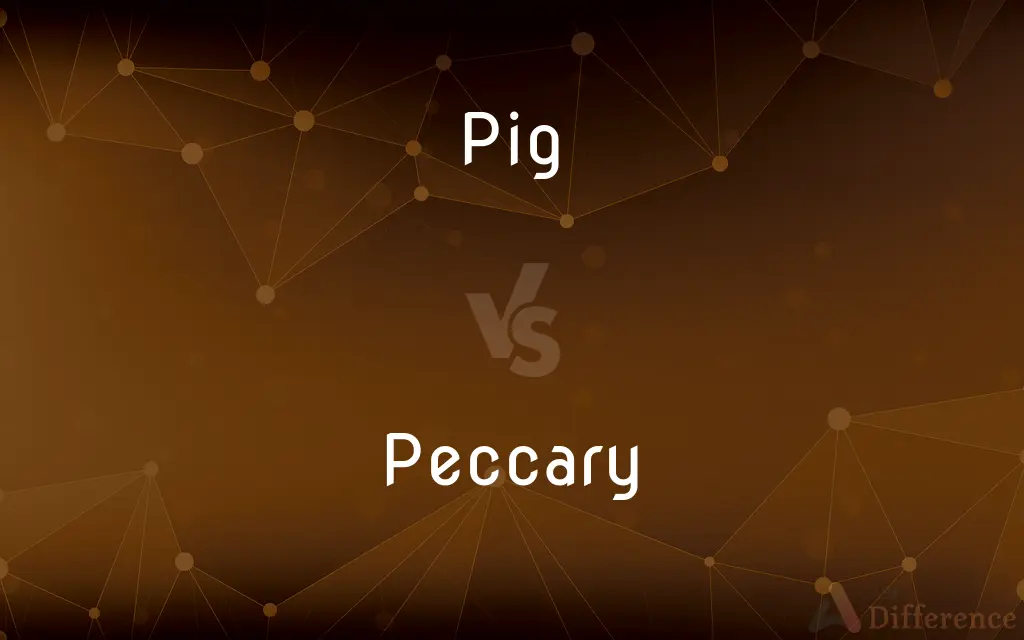Pig vs. Peccary — What's the Difference?
Edited by Tayyaba Rehman — By Fiza Rafique — Updated on March 18, 2024
Pigs are domesticated animals known for their role in agriculture and food production, while peccaries, often called javelinas, are wild, more aggressive, and found in the Americas.

Difference Between Pig and Peccary
Table of Contents
ADVERTISEMENT
Key Differences
Pigs, belonging to the family Suidae, are domesticated animals that have been integral to human agriculture for thousands of years. They are known for their intelligence, versatility in diet, and as a source of various products including meat, leather, and even medical materials. On the other hand, peccaries are wild animals from the Tayassuidae family, found primarily in Central and South America, and are adapted to a variety of habitats from arid deserts to rainforests.
While pigs are often characterized by their stocky body, flat snout, and relatively docile behavior when domesticated, peccaries are known for their sharper tusks, stronger herd instincts, and more aggressive behavior. This makes peccaries less suitable for domestication. Peccaries also have a distinctive gland on their back which secretes a strong-smelling odor, used for marking territory and social bonding.
Pigs are highly adaptable and can thrive in a wide range of environments, thanks to their long history of domestication and selective breeding. This has led to a variety of breeds with different sizes, colors, and temperaments. Peccaries, however, are typically found in specific ecosystems and have not undergone such extensive breeding, resulting in less variation among their species.
In terms of diet, both pigs and peccaries are omnivores, but their food sources can differ significantly due to their different habitats. Domestic pigs may be fed a controlled diet designed to maximize growth and health, often consisting of grains, vegetables, and protein supplements. Peccaries, on the other hand, forage for their food, which includes roots, fruits, insects, and small vertebrates.
The relationship with humans also marks a significant difference between the two. Pigs have been domesticated for a variety of uses, including food, research, and as pets. Peccaries, while not typically domesticated, can sometimes come into conflict with humans, especially in areas where their habitat overlaps with agricultural or urban areas, leading to peccaries raiding crops or gardens.
ADVERTISEMENT
Comparison Chart
Family
Suidae
Tayassuidae
Habitat
Worldwide, domesticated
Americas, wild
Behavior
Docile when domesticated
More aggressive, strong herd instincts
Uses
Food, leather, medical materials, pets
None in domestication, occasional crop raiding
Physical Features
Stocky body, flat snout
Sharper tusks, scent gland on back
Diet
Controlled diet (grains, vegetables)
Forages (roots, fruits, insects)
Human Interaction
Domesticated for various purposes
Not domesticated, can conflict with humans
Variation
High variation in breeds
Less variation among species
Compare with Definitions
Pig
Often kept as pets due to their docile nature.
She adopted a miniature pig as a pet.
Peccary
Live in herds and exhibit strong social bonds.
A herd of peccaries can aggressively defend against predators.
Pig
A domesticated mammal used in agriculture.
The farmer raised pigs for their meat.
Peccary
A wild mammal found in the Americas.
The collared peccary roams the deserts of the Southwest.
Pig
Diverse in breeds and colors.
The pink Yorkshire pig is popular in commercial farming.
Peccary
Omnivores, but diet varies greatly by habitat.
Peccaries in the rainforest eat fruits and roots.
Pig
Omnivorous animals, eating both plants and animals.
Pigs enjoy a diet rich in grains and vegetables.
Peccary
Recognizable by their tusks and scent gland.
Peccaries mark their territory with a strong scent.
Pig
Known for their intelligence and sociability.
Pigs can learn tricks just like dogs.
Peccary
Rarely interact positively with humans.
Peccaries can become a nuisance by raiding gardens.
Pig
A greedy, dirty, or unpleasant person
I bet he's scoffed them all, greedy pig
Peccary
A peccary (also javelina or skunk pig) is a medium-sized pig-like hoofed mammal of the family Tayassuidae (New World pigs). They are found throughout Central and South America and in the southwestern area of North America.
Pig
A pig is any of the animals in the genus Sus, within the even-toed ungulate family Suidae. Pigs include domestic pigs and their ancestor, the common Eurasian wild boar (Sus scrofa), along with other species.
Peccary
Any of several piglike hoofed mammals of the family Tayassuidae, found in North, Central, and South America and having stiff bristles and short, straight tusks.
Pig
An omnivorous domesticated hoofed mammal with sparse bristly hair and a flat snout for rooting in the soil, kept for its meat.
Peccary
Any of the family Tayassuidae of mammals from the Americas, related to pigs and hippos.
Pig
A police officer
Were the pigs there when the windows were smashed or not?
Peccary
A pachyderm of the genus Dicotyles.
Pig
An oblong mass of iron or lead from a smelting furnace.
Peccary
Nocturnal gregarious pig-like wild animals of North America and South America
Pig
A device which fits snugly inside an oil or gas pipeline and is sent through it to clean or test the inside, or to act as a barrier.
Pig
Gorge oneself with food
Lovesick people pig out on chocolate
Pig
Crowd together with other people in disorderly or dirty conditions
He didn't approve of the proposal to pig it in the studio
Pig
(of a sow) give birth to piglets; farrow.
Pig
Operate a pig within an oil or gas pipeline
They will carry out all trenching and pigging
Pig
Any of various mammals of the family Suidae, having short legs, hooves with two weight-bearing toes, bristly hair, and a cartilaginous snout used for digging, including the domesticated hog (Sus scrofa subsp. domestica syn. S. domesticus) and wild species such as the bushpig.
Pig
A domesticated hog, especially when weighing less than 54 kilograms (120 pounds).
Pig
The edible parts of one of these mammals.
Pig
(Informal) A person regarded as being piglike, greedy, or disgusting.
Pig
Derogatory Slang A police officer.
Pig
A crude block of metal, chiefly iron or lead, poured from a smelting furnace.
Pig
A mold in which such metal is cast.
Pig
Pig iron.
Pig
To give birth to pigs; farrow.
Pig
Any of several mammalian species of the genus Sus, having cloven hooves, bristles and a nose adapted for digging; especially the domesticated animal Sus domesticus.
The man kept a pen with two pigs that he fed everything from carrots to cabbage.
Pig
(uncountable) The edible meat of such an animal; pork.
Some religions prohibit their adherents from eating pig.
Pig
(uncountable) A light pinkish-red colour, like that of a pig (also called pig pink).
Pig
Someone who overeats or eats rapidly and noisily.
You gluttonous pig! Now that you've eaten all the cupcakes, there will be none for the party!
Pig
A dirty or slovenly person.
He was a pig and his apartment a pigpen; take-away containers and pizza boxes in a long, moldy stream lined his counter tops.
Pig
(derogatory) A very obese person.
Pig
A police officer.
The protester shouted, “Don't give in to the pigs!” as he was arrested.
Pig
(informal) A difficult problem.
Hrm... this one's a real pig: I've been banging my head against the wall over it for hours!
Pig
A block of cast metal.
The conveyor carried the pigs from the smelter to the freight cars.
After the ill-advised trade, the investor was stuck with worthless options for 10,000 tons of iron pig.
Pig
The mold in which a block of metal is cast.
The pig was cracked, and molten metal was oozing from the side.
Pig
A lead container used for radioactive waste.
Pig
(engineering) A device for cleaning or inspecting the inside of an oil or gas pipeline, or for separating different substances within the pipeline. Named for the pig-like squealing noise made by their progress.
Unfortunately, the pig sent to clear the obstruction got lodged in a tight bend, adding to the problem.
Pig
The general-purpose M60 machine gun, considered to be heavy and bulky.
Unfortunately, the M60 is about twenty-four pounds and is very unbalanced. You try carrying the pig around the jungle and see how you feel.
Pig
(uncountable) A simple dice game in which players roll the dice as many times as they like, either accumulating a greater score or losing previous points gained.
Pig
A sixpence.
Pig
(Scottish) earthenware, or an earthenware shard
Pig
An earthenware hot-water jar to warm a bed; a stone bed warmer
Pig
(of swine) to give birth.
The black sow pigged at seven this morning.
Pig
(intransitive) To greedily consume (especially food).
They were pigging on the free food at the bar.
Pig
(intransitive) To huddle or lie together like pigs, in one bed.
Pig
(intransitive) To live together in a crowded filthy manner.
Pig
To clean (a pipeline) using a pig the device.
Pig
A piggin.
Pig
The young of swine, male or female; also, any swine; a hog.
Pig
Any wild species of the genus Sus and related genera.
Pig
An oblong mass of cast iron, lead, or other metal. See Mine pig, under Mine.
Pig
One who is hoggish; a greedy person.
Pig
To bring forth (pigs); to bring forth in the manner of pigs; to farrow.
Pig
To huddle or lie together like pigs, in one bed.
Pig
Domestic swine
Pig
A coarse obnoxious person
Pig
A person regarded as greedy and pig-like
Pig
Uncomplimentary terms for a policeman
Pig
Mold consisting of a bed of sand in which pig iron is cast
Pig
A crude block of metal (lead or iron) poured from a smelting furnace
Pig
Live like a pig, in squalor
Pig
Eat greedily;
He devoured three sandwiches
Pig
Give birth;
Sows farrow
Common Curiosities
What is a peccary?
A peccary, often called a javelina, is a wild animal found in the Americas, known for its more aggressive nature, belonging to the Tayassuidae family.
Can peccaries be domesticated like pigs?
Peccaries are not typically domesticated due to their aggressive nature and specific habitat needs.
Do peccaries have any uses for humans?
Peccaries are not generally used by humans for agriculture or products but may come into conflict with human activities.
How are pigs used in medical research?
Pigs are used in medical research due to their physiological similarities to humans, contributing to advancements in medicine and surgery.
What do peccaries eat?
Peccaries are also omnivores but forage for roots, fruits, insects, and small vertebrates in their wild habitats.
What distinguishes the physical features of pigs and peccaries?
Pigs have a stocky body and flat snout, while peccaries have sharper tusks and a distinctive scent gland on their back.
What do pigs eat?
Domestic pigs are omnivores, often fed a controlled diet of grains, vegetables, and sometimes protein supplements.
Are there different breeds of peccaries like pigs?
While there are a few species of peccaries, they do not exhibit the same level of breed variation seen in domestic pigs.
Why are pigs important to humans?
Pigs are important for food, leather, medical materials, and sometimes as pets, due to their versatility and intelligence.
What is a pig?
A pig is a domesticated animal known for its role in agriculture and food production, belonging to the family Suidae.
How do pigs and peccaries differ in behavior?
Pigs can be quite docile when domesticated, while peccaries are known for their strong herd instincts and aggression.
How do pigs and peccaries interact with their environment?
Pigs are highly adaptable, thriving in a variety of environments due to domestication, while peccaries are adapted to specific wild habitats.
Can peccaries be a problem for farmers?
Yes, peccaries can raid crops or gardens, leading to conflicts with farmers in areas where their habitats overlap.
What makes peccaries unique among wild animals?
Peccaries are unique for their strong herd behavior, aggressive defense mechanisms, and the distinctive odor they use for communication and territory marking.
What challenges do peccaries face in the wild?
Peccaries face habitat loss, hunting, and competition for food as major challenges in the wild.
Share Your Discovery

Previous Comparison
Leotard vs. Bodysuit
Next Comparison
Demeanour vs. DemeanorAuthor Spotlight
Written by
Fiza RafiqueFiza Rafique is a skilled content writer at AskDifference.com, where she meticulously refines and enhances written pieces. Drawing from her vast editorial expertise, Fiza ensures clarity, accuracy, and precision in every article. Passionate about language, she continually seeks to elevate the quality of content for readers worldwide.
Edited by
Tayyaba RehmanTayyaba Rehman is a distinguished writer, currently serving as a primary contributor to askdifference.com. As a researcher in semantics and etymology, Tayyaba's passion for the complexity of languages and their distinctions has found a perfect home on the platform. Tayyaba delves into the intricacies of language, distinguishing between commonly confused words and phrases, thereby providing clarity for readers worldwide.













































